-
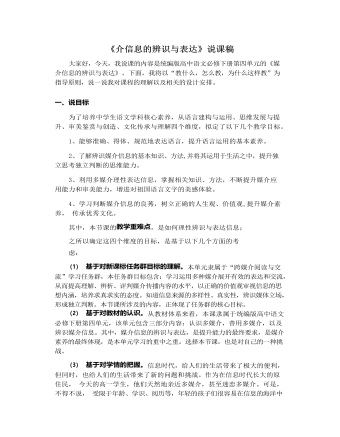
《媒介信息的辨识与表达》说课稿-2021-2022学年统编版高中语文必修下册
②癌症患者在治疗过程中,会有很大的身体损耗,而黄鳝有很好的滋补作用,适当吃一点黄鳝,既能够为患者补充营养,也能够提高患者的身体免疫力。 (来源于报纸)经过讨论交流,每一组一名同学自主发言,老师点拨,最后形成小结。看来源 要权威发布,不要道听途说看内容 要事实清晰,不要模糊遗漏看立场 要客观公允,不要情绪煽动看逻辑 要严谨准确,不要简单断言情感判断 理性判断 理性表达(四)活动三,重实践新课标提到,语文课程应引导学生在真实的语言运用情境中,通过自主的语言实践活动,积累经验,把握规律,培养能力。据此,我设计了以下贴近学生生活、可参与性强的活动。多媒体展示案例,仍然是先讨论交流,再自主发言,说出案例有哪些问题。这是某校园论坛上的一则寻物启示。

《念奴娇·赤壁怀古》说课稿(二) 2022-2023学年统编版高中语文必修上册
读,是学生接触作品最直接的方式。初读词作,让学生听示范读,并且在课本注解的提示下,解决词作的读音问题。再进一步了解词人情况、本词的创作背景以及怀古咏史诗词的基本情况。通过齐读的方式,亲身感受词作的音韵之美。读,是放飞想象的最好方式。再读词作,通过诵读上阙内容,想象上阙描绘了一幅什么样的情景?用了哪些富有表现力的词来极力描绘这些景象?呈现出何种意境?有何作用?并且利用智慧课堂进行填空和选择。读,是把握内容的最有用的方式。通过智慧课堂随机选择,引导学生分角色诵读下阙,分析三国时的周瑜与此时的词人苏轼的形象。在对比中,感受周瑜的情场、官场、战场,场场得意的情况,和苏轼的黄州、惠州、儋州,州州失意的人生境遇。理解周瑜之于苏轼而言,是某种程度上热切向往的和难以企及的梦。读,也是赏析体悟作品主要方式。学生再次齐读下阙,赏析词作最后两句“人生如梦,一尊还酹江月”表达了作者怎样的情感?来完成本篇内容的学习。
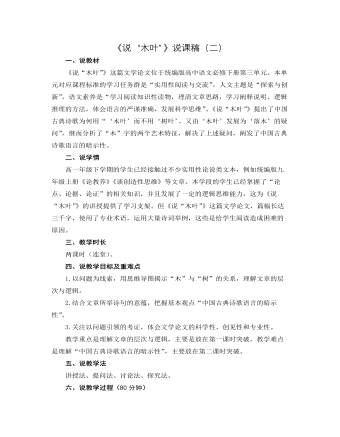
《说“木叶”》说课稿(二) 2021-2022学年统编版高中语文必修下册
一、说教材《说“木叶”》这篇文学论文位于统编版高中语文必修下册第三单元。本单元对应课程标准的学习任务群是“实用性阅读与交流”,人文主题是“探索与创新”,语文素养是“学习阅读知识性读物,理清文章思路,学习阐释说明、逻辑推理的方法,体会语言的严谨准确,发展科学思维”。《说“木叶”》提出了中国古典诗歌为何用“‘木叶’而不用‘树叶’、又由‘木叶’发展为‘落木’的疑问”,继而分析了“木”字的两个艺术特征,解决了上述疑问,阐发了中国古典诗歌语言的暗示性。二、说学情高一年级下学期的学生已经接触过不少实用性论说类文本,例如统编版九年级上册《论教养》《谈创造性思维》等文章。本学段的学生已经掌握了“论点、论据、论证”的相关知识,并且发展了一定的逻辑思维能力,这为《说“木叶”》的讲授提供了学习支架。但《说“木叶”》这篇文学论文,篇幅长达三千字,使用了专业术语,运用大量诗词举例,这些是给学生阅读造成困难的原因。
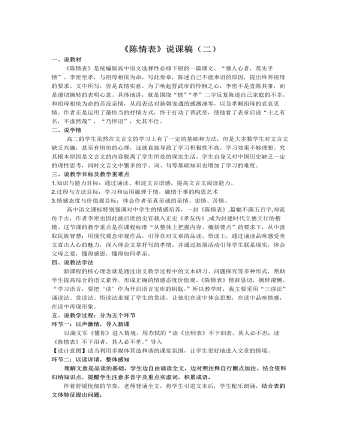
《陈情表》说课稿(二) 2021-2022学年统编版高中语文选择性必修下册
概括出祖母的形象:祖母是一位对我恩重如山,身缠重病,风烛残年的老人。(紧扣“婴”,)了解作者身世:“生孩六月,慈父见背;行年四岁,舅夺母志。祖母刘,悯臣孤弱,躬亲抚养。臣少多疾病,九岁不行,零丁孤苦,至于成立。既无伯叔,终鲜兄弟;门衰祚薄,晚有儿息。外无期功强近之亲,内无应门五尺之僮。茕茕孑立,形影相吊。”(概括明确:“孤苦”“孤弱”,突出“孤”)【先分析“应该尽忠”和“不得不去尽忠”,再分析“不能去尽忠”,避免了串讲课文的平淡与枯燥,使课堂有了波澜。】(三)追问探究,察理析忠孝问题:只说自身孤苦、祖母多病是“以情动人”,或许能打动一个君王,但是对于像晋武帝这样一个君王就很难说了。晋武帝究竟是一个什么样的君王?李密又是用什么理由说服他的呢?其间体现了作者怎样的机变和才智呢?
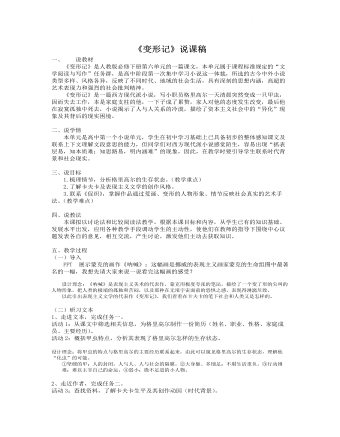
《变形记(节选)》说课稿 2021-2022学年统编版高中语文必修下册
五、教学过程(一)导入PPT 展示蒙克的画作《呐喊》:这幅画是挪威的表现主义画家蒙克的生命组图中最著名的一幅,我想先请大家来说一说看完这幅画的感受?设计理念:《呐喊》是表现主义美术的代表作,蒙克用极度夸张的笔法,描绘了一个变了形的尖叫的人物形象,把人类的极端的孤独和苦闷,以及那种在无垠宇宙面前的恐惧之感,表现得淋漓尽致。以此引出表现主义文学的代表作《变形记》,我们看看在卡夫卡的笔下社会和人类又是怎样的。(二)研习文本1、走进文本,完成任务一。活动1:从课文中筛选相关信息,为格里高尔制作一份简历(姓名、职业、性格、家庭成员、主要经历)。活动2:概括甲虫特点,分析其表现了格里高尔怎样的生存状态。设计理念:将甲虫的特点与格里高尔的主要经历联系起来,由此可以窥见格里高尔的生存状态,理解他“化虫”的可能。①坚硬的甲:人的封闭,人与人、人与社会的隔膜。②大身躯、多细足:不堪生活重负。③行动困难:难以主宰自己的命运。④弱小:微不足道的小人物。
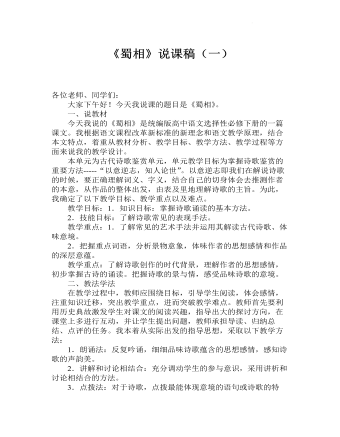
《蜀相》说课稿(一) 2021-2022学年统编版高中语文选择性必修下册
我将本节课分为三个部分:1.情境导入先运用多媒体,展示电影《赤壁》的几张图片,通过“赤壁之战”将三国时期这场经典战争诸葛亮的智谋呈现给学生,吸引学生走进历史,激发想象力和趣味性,提高学生的学习主动性。在成功吸引学生注意力过后,再向他们说,这只是历史中的一部分,在“赤壁之战”前后,诸葛亮一生的故事是怎样的呢?下面我们来看看唐代大诗人杜甫的《蜀相》,他是怎样用精辟的诗句概括的。2.讲授新课在成功吸引学生注意力后,迅速将他们带入课文讲授阶段。第一,进行作者介绍,其目的是为了使学生在整体上把握诗人的经历、写作技巧、艺术风格及写作背景。第二,多诵读,多推敲,理解诗中的言外之意。第三,把握重点词语,分析景物意象,体味作者的思想感情和作品的深层意蕴。感受诗人忧国忧民强烈的爱国主义感情。
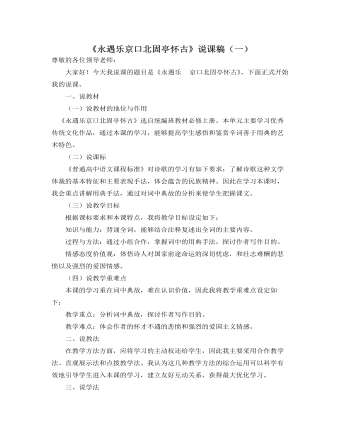
《永遇乐 · 京口北固亭怀古》说课稿(一) 2021-2022学年统编版高中语文必修上册
(三)以读带讲,感知文本1.学生朗读首先我会让学生结合书下的注释自由大声的朗读本篇课文,扫清文字障碍,感知词意。此环节可以让学生在诵读中解决词中的生字困难,疏通文意。2.教师范读我会声情并茂、感情充沛的进行配乐朗诵。此环节力求让学生感受到词的音乐美,懂得词的朗诵方法,为深入理解词的内容做准备。(四)精讲细读,深入文本此环节主要解决本课的重点,所以我会运用合作教学法和点拨教学法引导学生分析词中典故,探讨作者写作目的。首先我将学生分为孙权刘裕组、刘义隆组、拓跋焘组、廉颇组四个小组。然后对这四个小组分别提出思考问题,让学生以小组为单位解决我提出的问题。在学生讨论结束后分别找每个小组中的一位同学回答,并引导点拨学生答案。孙权刘裕组:
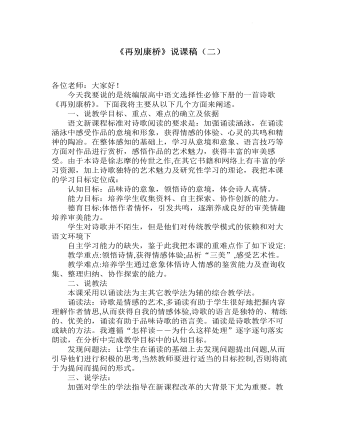
《再别康桥》说课稿(二) 2021-2022学年统编版高中语文选择性必修下册
康桥风光、剑桥大学风貌(配上剑桥的优美图片,让学生从视觉上对课文有一定的感知,帮助理解诗人的“康桥情结”)2.诵读体味(教学重点的解决)先让学生自由朗诵。要求学生谈谈对全诗的整体感受教师稍加点拨,答案不需标准,只要整体把握正确即可。然后逐字逐句指导朗诵并结合作者独特的人生际遇分析本诗所体现的诗情和艺术上的“三美”,从而达到准确把握作品主旨的目的。这种引导是循序渐进的,也符合学生的认知规律。简介诗歌“三美”追求闻一多先生是我国现代文学史上集诗人、学者和斗士于一身的重要诗人。他不但致力于新诗艺术美的探索,提出了音乐美(音节)、绘画美(词藻)、建筑美(节的匀称和句的均齐)的诗歌\"三美\"的新格律诗理论主张,还努力进行创作实践,写出了许多精美诗篇。他的新格律诗理论被后人称为现代诗学的奠基石,影响深远。
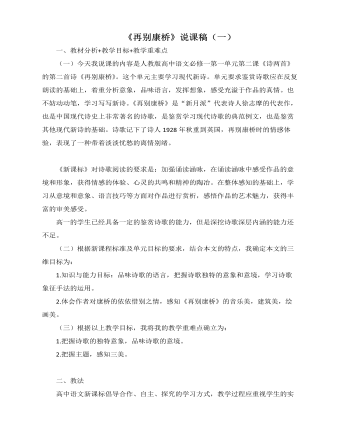
《再别康桥》说课稿(一) 2020-2021学年统编版高中语文选择性必修下册
2.对比联想法。让学生在诵读的基础上,对《再别康桥》中康桥美景的赏析和意象进行解读,引导学生欣赏诗歌的画面美,从而受到审美的体验。3.探究式学习法。引导学生对《再别康桥》情感和主题的探究。充分发挥学生自主学习的能力,引导学生主动地获取知识,重视学生的实践活动。三、学法1、诵读法 加强诵读,这是阅读诗词的一般方法。2、体悟法 通过意象把握情感,主要是让学生设身处地走进雨巷去感悟。3、联想比较法 通过与诗人的其他作品的比较学习,体会创作风格及作者情感。四、教学过程教学过程设计一、导入自古以来,离别总免不了沉重的愁绪。比如王维《宋元二使安西》:劝君更尽一杯酒,西出阳关无故人。李白《黄鹤楼送孟浩然之广陵》:孤帆远影碧空尽,唯见长江天际流。柳永《雨霖铃》执手相看泪眼,竟无语凝噎。正所谓自古多情伤离别,更那堪冷落清秋节啊。(设计目的:以离别主题的诗歌导入课文,让学生更快地进入课文情境。)
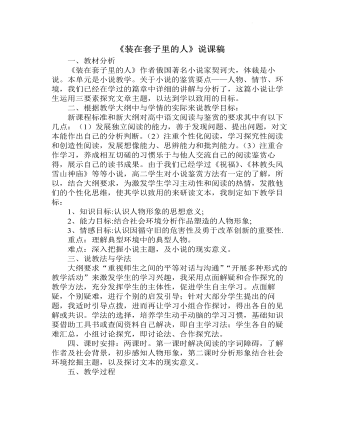
《装在套子里的人》说课稿 2021-2022学年统编版高中语文必修下册
8、板书装在套子里的人别里科夫的形象——有形的套子套己——无形的套子套人第二课时合作探究:目标挖掘主题及现实意义。问题设置,衔接上节课内容,层层深入。1、结合上节课别里科夫的形象分析:他的思想被什么套住,其悲剧原因在哪?(根据人物形象的分析与社会背景的了解,直击主题。)沙皇腐朽的专制统治套住了他的思想,沙皇的清规戒律使他不敢越雷池一步,所以他是受害者,但他的身份性格以及特定的社会环境,又让他成为沙皇统治的捍卫者。2、他恋爱的情节以及科瓦连科这两个人物的塑造的意义?(从人物以及主题入手,推翻沙皇的腐朽反动的统治,必须是每一个人都敢于打破套子,唤醒革新,更新观念,拒绝腐朽。)别里科夫渴望打破束缚,也想革新,而科瓦连科两个人物体现朝气活泼,以及勇于打破常规束缚的勇气,为革新升起了一片曙光。3、塑造别里科夫的手法,除了一般刻画人物方法外,还有什么方法?
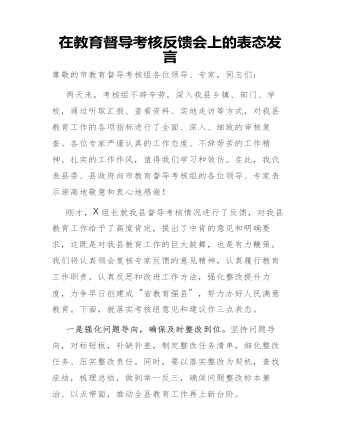
在教育督导考核反馈会上的表态发言
一是强化问题导向,确保及时整改到位。坚持问题导向,对标短板,补缺补差,制定整改任务清单,细化整改任务、压实整改责任。同时,要以落实整改为契机,查找症结,梳理总结,做到举一反三,确保问题整改标本兼治、以点带面,推动全县教育工作再上新台阶。
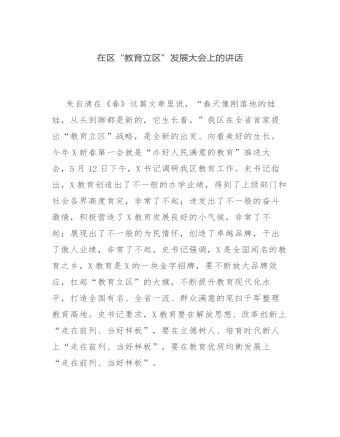
在区“教育立区”发展大会上的讲话发言
一、要更加自觉传承优良传统,永葆X教育的“春泥芬芳”X教育之所以持久芬芳,得益于教风、体系和环境“三大优势”,这是X教育赖以生长的肥沃土壤。我们的园丁“敬业+专业”,“优秀的人”才能培养“更优秀的人”,广大教育工作者默默无闻、敬业奉献、专业精湛,这是我区教育界无形的宝贵财富;我们的体系“均衡+优质”,高考成绩的背后,是优质均衡的体系支撑,体现为办学的集团化、主体的特色化、竞争的良性化;我们的保障“全力+全面”,历届区委区政府高度重视、深切关怀教育事业,各地各部门也把教育发展作为分内之责,各地商会企业、慈善组织积极捐资助学。
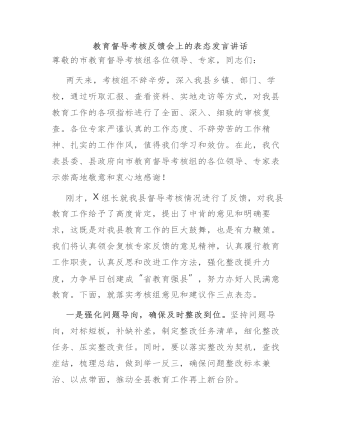
在教育督导考核反馈会上的表态发言讲话
一是强化问题导向,确保及时整改到位。坚持问题导向,对标短板,补缺补差,制定整改任务清单,细化整改任务、压实整改责任。同时,要以落实整改为契机,查找症结,梳理总结,做到举一反三,确保问题整改标本兼治、以点带面,推动全县教育工作再上新台阶。
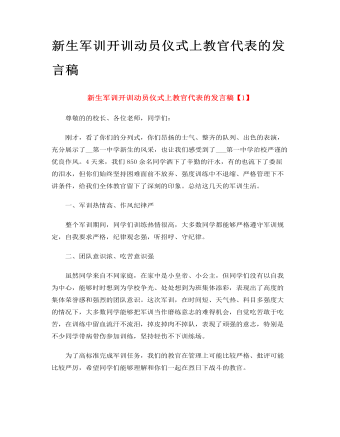
新生军训开训动员仪式上教官代表的发言稿
同学们,军训很苦,苦的让人不愿坚持,但军训也很甜,他可以增强我们的体魄,深化我们的情感,提升我们的思想境界。为此,我对同学们提出三点要求: 一、要求同学们要把自己当做一名真正的军人,严格要求自己,继承和发扬不怕苦、不怕累、艰苦奋斗的精神,克服困难、努力拼搏,圆满完成军训任务。 二、希望同学们在接下来的军训中,学会关心集体,关心他人,建立深厚的战友情、同学情,增强班级荣誉感。 三、希望同学们每天训练后要认真总结,及时深化心灵深处的精神力量,使之成为将来学习、生活和工作所需的宝贵财富。

新人教版高中英语必修3Unit 1 Festivals and celebrations-Discovering Useful Structure教学设计
4.That was an experience that frightened everyone. →That was _____________________. 答案:1. taking 2. being discussed 3. in the reading room 4. a frightening experienceStep 6 The meaning and function of V-ing as the predicative动词-ing形式作表语,它通常位于系动词后面,用以说明主语“是什么”或“怎么样”一种表示主语的特质、特征和状态, 其作用相当于形容词; 另一种具体说明主语的内容, 即主语等同于表语, 两者可互换。The music they are playing sounds so exciting. 他们演奏的音乐听起来令人激动。The result is disappointing. 结果令人失望。Our job is playing all kinds of music. 我们的工作就是演奏各种音乐。Seeing is believing. 眼见为实。Step 7 Practice1. It is ________(amaze) that the boy is able to solve the problem so quickly.2. Buying a car is simply _______(waste) money. 3. Please stop making the noise—it’s getting ________(annoy). 4. complete the passage with the appropriate -ing form.La Tomatina is a festival that takes place in the Spanish town Bunol every August. I think many food festivals are __________ because people are just eating. however, this festival is _________ because people don't actually eat the tomatoes. Instead, they throw them at each other! the number of people ________ part in this tomato fight, can reach up to 20,000, and it is a very __________ fight that lasts for a whole hour. The _______ thing is how clean Bunol is after the tomatoes are washed away after the fight. this is because the juice form tomatoes is really good for making surfaces clean!答案:1. amazing 2. wasting 3. annoying4. boring interesting taking exciting amazing

新人教版高中英语必修3Unit 1 Festivals and Celebrations-Reading and Thinking教学设计
The topic of this part is “Discover the reasons for festivals and celebrations.The Listening & Speaking & Talking part aims at talking about the experiences and feelings or emotions about the festivals and celebrations. This section aims at detecting the reason why the people celebrate the festivals, the time, the places, the types and the way of celebrations. It also explains why some traditions in the old celebrations are disappearing, like the firecrackers in the big cities and some new things are appearing like the prosperity of business or commerce. 1. Students can talk about what festivals they know and the reasons and the way of celebrating them.2. Students should learn the reading skills such as the headline and get the topic sentences, the structures of articles.3. Students can understand the past, the present situation of some festival around the world and why there are some changes about them. 4. Students can have the international awareness about the festivals.1. Students should learn the reading skills such as the headline and get the topic sentences, the structures of articles.2. Students can understand the past, the present situation of some festival around the world and why there are some changes about them.Step 1 Lead in---Small talkWhat festival do you like best ? Why ?I like the Spring Festivals because I can set off the fireworks, receive the lucky money and enjoy the Gala with my families.Step 2 Before reading---Pair workWhy do people celebrate different festivals ?The Spring Festivals is to celebrate the end of winter and the coming of spring and new life.The Mid-autumn Day is to celebrate the harvest and admire the moon.

新人教版高中英语必修3Unit 1 Festivals and Celebrations-Listening &Speaking&Talking教学设计
The theme of this section is “Talk about festival activities and festival experiences”.Festival and holiday is a relaxing and interesting topic for students. This part talks about the topic from the daily life of students’. In the part A ---Listening and Speaking, there are three conversations among different speakers from three countries(Japan, Rio and China), where the speakers are participating in or going to participate in the festivals and celebrations. So listening for the relationship among them is a fundamental task. Actually, with the globalization and more international communication, it is normal for Chinese or foreigners to witness different festivals and celebrations in or out of China. In the Conversation 1, a foreign reporter is interviewing a Japanese young girl who just had participated in the ceremony of the Coming-of-Age Day on the street and asking her feeling about the ceremony and the afterwards activities. Conversation 2, Chinese girl Li Mei is witnessing the Rio Carnival for the first time, and her friend Carla gives her some advice on the costumes which enables her to match with the carnival to have a good time. Conversation 3, a Chinese guide is showing a group of foreign visitors around the Lantern Festival and introducing the customs of the festival to them. The three conversations have a strong vitality and insert the festival and cultural elements from different countries. So perceiving the festivals and cultures from different countries is the second task. At the same time, the scripts also insert the targeted grammar --- v-ing as attributive and predicative, which students can perceive and experience in a real context and make a road for the further study. That is the third task. In the Part B--- Listening and Talking, the theme is “Talk about festival experience”, which is the common topic in our daily conversations. During the conversation, Song Lin, a Chinese student, asked Canadian friend Max about how to spend Christmas. In the conversation, Song Lin talked about experience and the feelings during the Chinese Spring Festival, during which there are not only some enjoyable things but some unpleasant things. After the listening, perhaps students find there are some similarities between Christmas and the Chinese Spring Festival as there are some differences in the origins and celebrations. For example, people always visit friends and relatives, decorate their houses, have a big dinner together, chat and give presents to each other.

新人教版高中英语必修3Unit 1 Festivals and Celebrations-Reading for writing教学设计二
Step 3 Analyzing article structureActivity 31. Teachers raise questions to guide students to analyze the chapter structure of this diary and think about how to describe the festival experience. (1)What should be included in the opening/body/closing paragraph(s)?(2)How did the writer arrange his/her ideas?(3)What kind of interesting details did the writer describe?(4)How did the writer describe his/her feelings/emotions during the event?2. Students read and compare the three sentence patterns in activity 2. Try to rewrite the first paragraph of the diary with these three sentence patterns. After that, students exchange corrections with their partners. Such as:●This was my first time spending three days experiencing the Naadam Festival in China’s Inner Mongolia Autonomous Region and it was an enjoyable and exciting experience. ●I'll never forget my experience at the Naadam Festival because it was my first time to watch the exciting Mongolian games of horse racing, wrestling, and archery so closely. ●I'll always remember my first experience at the Naadam Festival in China’s Inner Mongolia Autonomous Region because it was so amazing to spend three days witnessing a grand Mongolian ceremony. Step 4 Accumulation of statementsActivity 41. Ask the students to read the diary again. Look for sentences that express feelings and emotions, especially those with the -ing form and the past participle. Such as:● …horse racing, wrestling, and archery, which are all so exciting to watch. ● some amazing performances● I was surprised to see…● I was a little worried about. . . ● feeling really tiredOther emotional statements:●I absolutely enjoyed the archery, too, but the horse races were my favourite part. ●I'm finally back home now, feeling really tired, but celebrating Naadam with my friend was totally worth it. ●He invited me back for the winter to stay in a traditional Mongolian tent and cat hot pot. I can’t wait!2. In addition to the use of the -ing form and the past participle, the teacher should guide the students in the appreciation of these statements, ask them to memorize them, and encourage them to use them reasonably in writing practice.

新人教版高中英语必修3Unit 1 Festivals and Celebrations-Reading for Writing教学设计一
The topic of this part is “Write about your festival experience”.During the Listening and Speaking and Talking, students are just asked to say out their festival experiences such as the Spring Festival, Mid-autumn Day, but this part students will be asked to write down their own festival experiences. During the reading part, it introduces the Naadam Festival in Inner Mongolia Autonomous Region, which can give students a good example to imitate. Students not only learn the festival, but touch and feel the Inner Mongolian’s character, the spirit and cultural atmosphere, which can help students form the cultural awareness and learn to enjoy and value the diversity of Chinese culture.Concretely, the dairy tells the experience that the author spent the Naadam Festival in Inner Mongolia Autonomous Region with his/her friend. The structure is clear. In the opening paragraph, it introduces the topic of the Naadam Festival and the whole feeling. Then it introduces the items of the festival like the ceremony, wrestling and horse racing. Finally, it summarizes this experience. Because this part is a travel journal, we must guide students pay more attention to these details: 1. use the first person. 2. use the past tense to tell the past thing and use the present or future tense to describe the scenery. 3. use the timeline to tell the development. 4. be careful for the author’s psychology, emotion and feeling, etc.1. Read quickly to get main idea; read carefully to get the detailed information about Naadam Festival.2. Learn the structure of the reading article and language.3. Write an article about a festival experience4. Learn to use the psychology, emotions and feeling in the writing.1. Write an article about a festival experience.2. Use the structure of the reading article and language.

新人教版高中英语必修3Unit 2 Morals and Virtues-Discovering Useful Structure教学设计
1. 表示时间。Hearing these stories, I’m skeptical about the place. = When I heard these stories. . . 2. 表示原因。Not knowing his address, I can’t send this book to him. = Because/Since/As I don’t know his address. . . 3. 表示结果。His father died, leaving him a lot of money. =. . . and left him a lot of money4. 表示条件。Going straight down the road, you will find the department store. = If you go straight down the road. . . 5. 表示让步。Being tired, they went on working. =Although they were tired. . . 6. 表示行为方式、伴随情况或补充说明。He lay on the grass, staring at the sky for a long time. =. . . and stared at the sky for a long time注意:非谓语动词作状语时, 如所提供的动词不能和句子中的主语保持一致, 动词-ing形式必须有自己的逻辑主语, 通常由名词或代词来担任, 这就是独立主格结构。The last bus having gone, we had to walk home. (having gone的逻辑主语是the last bus, 而不是we)Weather permitting, the football match will be played on Friday. (permitting的逻辑主语是time, 而不是the football match)Step 7 Practice1. ________(study) hard, you are sure to get first prize. 2. People use plastic in their daily life, _______(leave) large amounts of waste. 3. ________(work) hard at your lessons, you are to succeed. 4. The old man, ____________(work) abroad for twenty years, is on the way back to his motherland. 5. ______________(finish) his homework, he was playing on the playground. Answers: 1. Studying 2. leaving 3. Working 4.having worked 5. Having finishedStep 8 HomeworkFinish the homework on Page 22.

